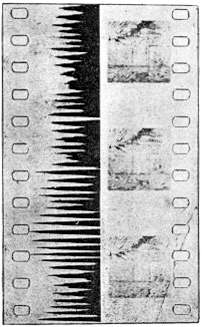 Former Edison machinist Eugène Lauste, then living in England, applied for a British patent on an early sound-on-film process in 1906. A working experimental system was operating as early as sometime circa 1911. The 35mm system captured a one-third size image on the right side of the camera negative while a primitive optical soundtrack was recorded on the left. One experimental Lauste camera was modified from a Pathé Frères camera. The playback projector recreated the soundtrack by projecting light through the optical soundtrack onto a selenium cell which coverted light into electrical pulses which were converted to sound and heard through earphones. Lauste never received the necessary funding to develop a sound amplification system. Former Edison machinist Eugène Lauste, then living in England, applied for a British patent on an early sound-on-film process in 1906. A working experimental system was operating as early as sometime circa 1911. The 35mm system captured a one-third size image on the right side of the camera negative while a primitive optical soundtrack was recorded on the left. One experimental Lauste camera was modified from a Pathé Frères camera. The playback projector recreated the soundtrack by projecting light through the optical soundtrack onto a selenium cell which coverted light into electrical pulses which were converted to sound and heard through earphones. Lauste never received the necessary funding to develop a sound amplification system.
Four brief 35mm nitrate print clippings survive in America, with two held by the Los Angeles County Museum of Natural History (Earl Theisen collection), one held by the Smithsonian, and one by private collector Rocco Accetturo who also holds Lauste papers previously part of the Jean LeRoy collection.
It is our conjecture that the Accetturo clipping (24 frame long) is an earlier example of the Lauste system as the cinematic image is smaller than the Smithsonian clipping (taken in 1912 and only 15 frames long), which captured a larger image perhaps addressing a need for a clearer image to accompany the recorded sound.
References: Website-MIAN. Webpage: Detecting the History of Sound-on-Film
Video: Examples of early Lauste sound-on-film experiments survive in America |




































